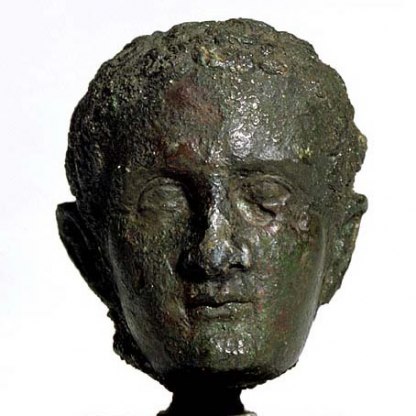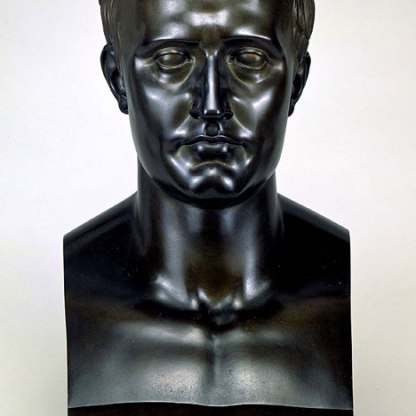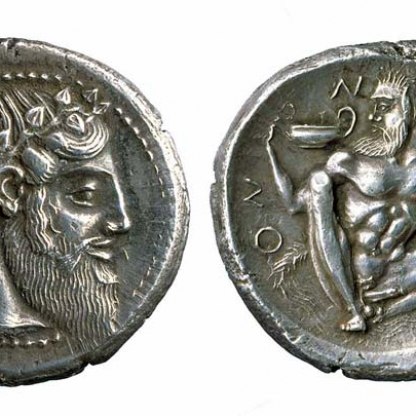Denarius of Brutus

'Brutus stamped, upon the coins which were being minted, his own likeness and a cap and two daggers indicating by this and by the inscription that he and Cassius had liberated the fatherland.'
Dio Cassius, Roman History, 47, 25, 3
This coin, so remarkable even in antiquity that it was mentioned by the Roman historian Dio Cassius (150–235 CE), commemorates the assassination of Gaius Julius Caesar in 44 BCE. Marcus Junius Brutus, whose face appears on the obverse side, was one of several conspirators who stabbed this powerful general and statesman to death during a meeting of the Roman Senate. Brutus left Italy a few months after the murder, and this coin was minted while he was campaigning in the East.
The reverse side shows a pileus, the cap worn by recently freed slaves that had become a more general symbol of liberty. It is flanked by two daggers, the weapons used to kill Caesar. And if this were not enough to remind the Roman citizen of the recent bloodshed, then the legend EID MAR is stamped beneath the emblems. This abbreviates Idus Martiae – the Ides (15th) of March – the date on which the murder took place.
This side of the coin, then, stands both as a celebration of freedom and as a warning to others who would upset the established Republican government. One is reminded of a gold crown, left, issued by Oliver Cromwell, the great English Republican, in 1658, which bears the legend Pax Quaeritur Bello – 'Peace is sought through War'. Freedom, Brutus’ coin insists, is secured with the dagger.
It is all the more remarkable, then, that the self-proclaimed liberator had himself portrayed so unashamedly on the other side of the coin. Rome had been a Republic, governed by a Senate, since 509 BCE, when the unpopular king, Tarquin the Proud, was expelled. It is the son of this Tarquin who we see assaulting the virtuous Roman lady Lucretia in Titian’s magnificent painting in the Fitzwilliam, a crime that led to a popular uprising against the Roman monarchy. Brutus himself claimed descent from the leader of this insurrection.
Under the Republic, it was taboo for any living individual to have himself portrayed on a coin, for to do so smacked of autocracy. Early in 44 BCE Julius Caesar had been appointed ‘Perpetual Dictator’, in an attempt to bring political stability to Rome, and the king-like powers that he had accrued provided the principal motivation behind his assassination. When he issued coins bearing his own image it was, for many, a step too far towards monarchy.
Yet here is Brutus, advertising himself as the liberator of Rome while appearing in profile on his own coin. The inscription refers to L. Plaetorius Cestanius, Brutus’ financial officer, and describes Brutus himself as Imperator, the word which would eventually denote Emperors of Rome.
Ironically, the murder of Julius Caesar set into motion a series of power struggles and civil wars that would finally put an end to Republicanism in Rome for ever and see the establishment of imperial rule. In 42 BCE, Brutus committed suicide after his army lost a crucial battle at Philippi in north-east Greece. They had been defeated by the joint forces of Marcus Antonius – most famous as the lover of Cleopatra of Egypt – and Octavian, Julius Caesar’s adopted son and heir.
By 31 BCE, 13 years after Caesar’s assassination, having defeated Antony and Cleopatra at the battle of Actium, Octavian was the most powerful figure in Roman politics. He changed his name to Augustus, and, little by little, assumed monarchical powers. A coin from his reign, left, depicts his profile head, wreathed with laurel, and gives some of his titles: Caesar Augustus, Son of the God (i.e. Julius Caesar) and Father of his Country.
Thereafter the chief of the Roman Empire always bore the title Caesar, after the man stabbed in the name of liberty on the Ides of March, 44 BCE.
Themes and periods
Data from our collections database
Acquisition and important dates
- Method of acquisition: Given
- Dates: 1963-11-21
Dating
mint moving with Brutus
Maker(s)
- Marcus Junius Brutus Moneyer
- Lucius Plætorius Cestus Moneyer
- Rome Place of use
Note
Mint moving with Brutus
Place(s) associated
- Rome
Materials used in production
Read more about this recordOther highlight objects you might like
Suggested Curating Cambridge products
Sign up to our emails
Be the first to hear about our news, exhibitions, events and more…





